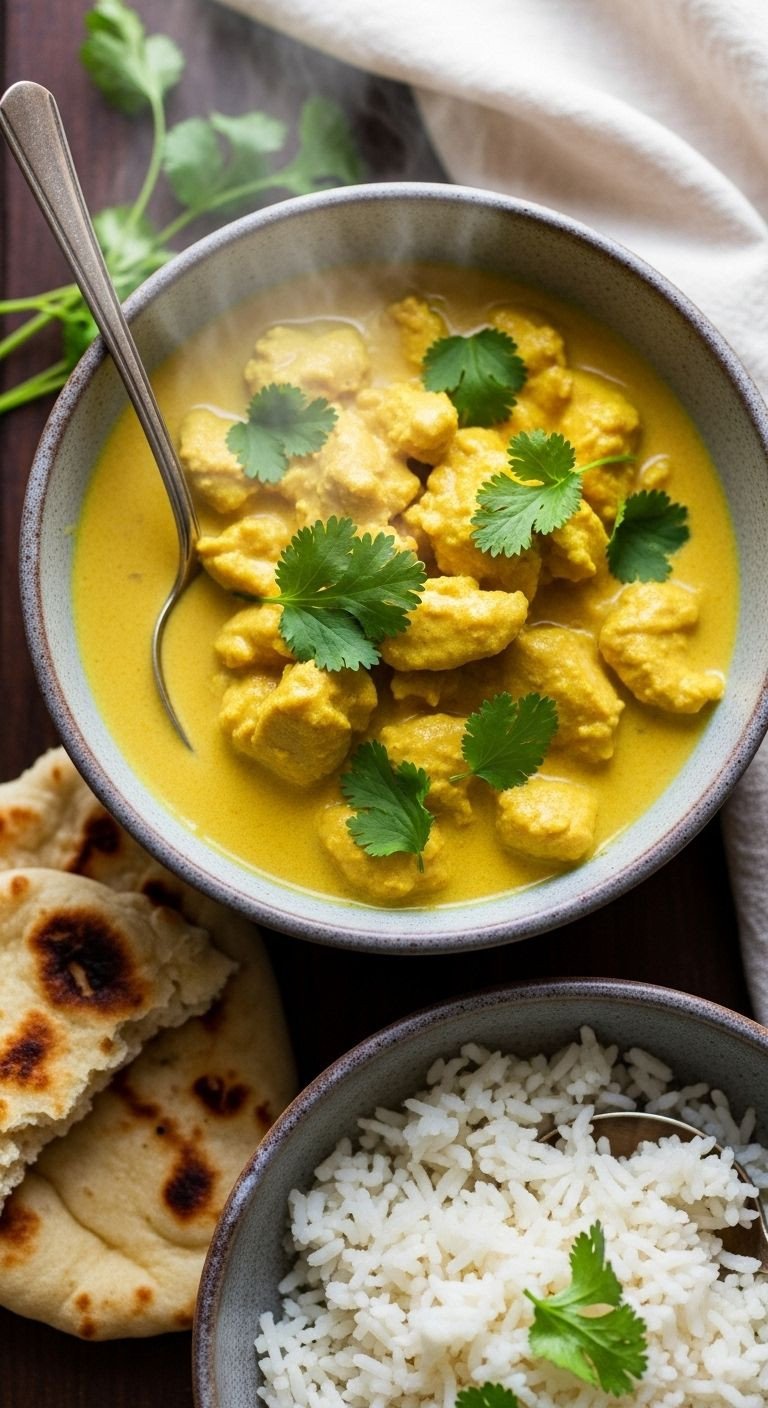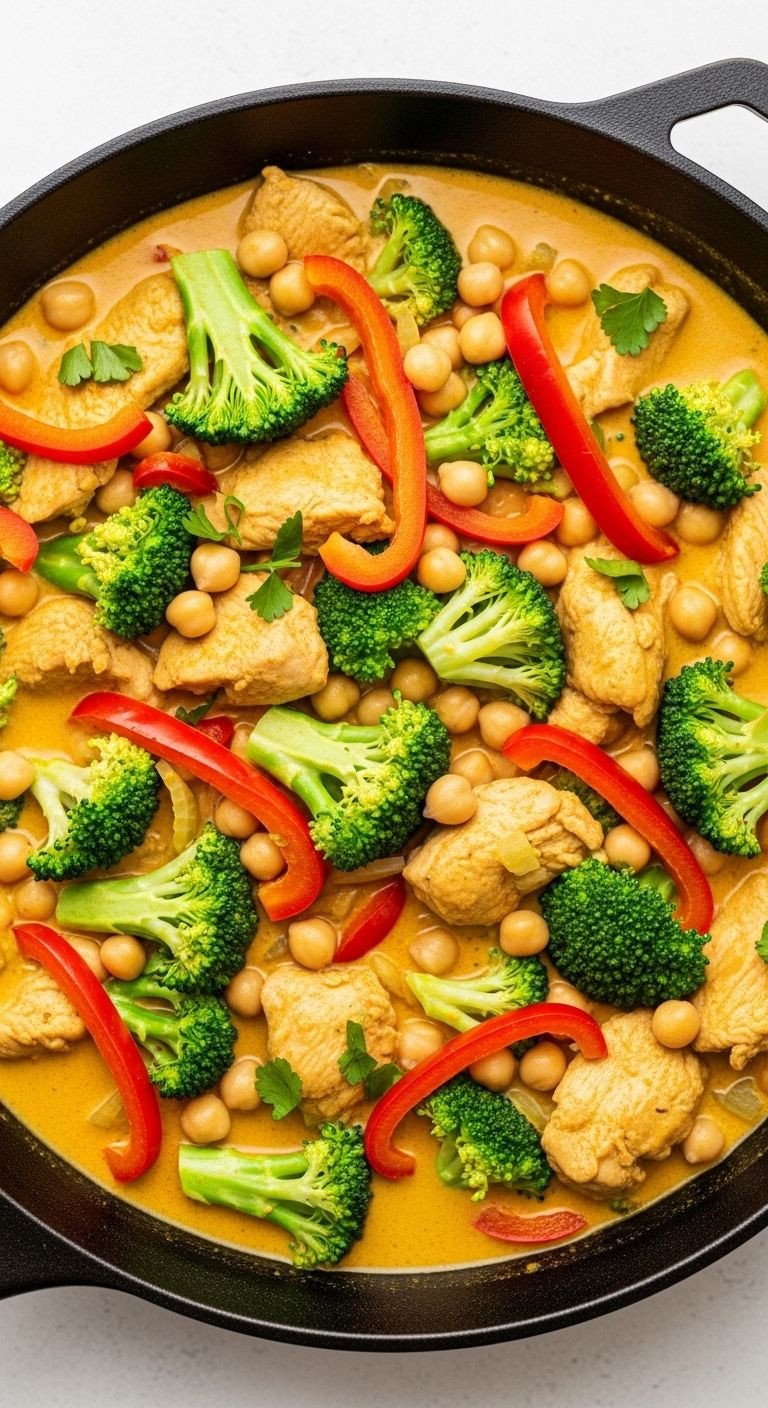As an Amazon Associate KitchenwareSets.com earns from qualifying purchases.
Easy Creamy Coconut Chicken Curry Recipe
Craving a dinner that’s both incredibly comforting and ridiculously easy? A meal that tastes like it simmered for hours but actually comes together faster than you can decide on a takeout order? You’re picturing a rich, aromatic bowl of curry, but the thought of a long ingredient list and complicated steps makes you reach for the phone.
Let’s be honest, weeknights are chaotic. Between work, family, and just trying to catch your breath, the last thing you want is a kitchen project that leaves you with a pile of dishes. You want flavor, you want comfort, and you want it now. The delivery apps call to you, promising convenience but often delivering lukewarm, expensive, and underwhelming results.
Here’s the deal: this creamy coconut chicken curry is your 30-minute solution to weeknight dinner dilemmas. It’s a one-pot wonder featuring tender, bite-sized chicken simmered in a luxuriously creamy and savory curry sauce. Made with simple, pantry-friendly ingredients, this recipe delivers a better-than-takeout experience with minimal effort and cleanup, making you feel like an absolute kitchen hero.
Craving a Cozy Dinner? Make This Creamy Coconut Chicken Curry in Under 30 Minutes
The secret to a truly satisfying weeknight meal is finding that perfect balance of speed, simplicity, and spectacular flavor, and this easy, one-pot coconut chicken curry is ready in under 30 minutes. It features tender chicken simmered in a rich and aromatic curry sauce made with full-fat coconut milk and simple spices, making it the ultimate better-than-takeout dinner that will have everyone asking for seconds. In my experience, having a go-to recipe like this in your back pocket is a game-changer for busy evenings.
Why This Will Be Your New Favorite Weeknight Recipe
This isn’t just another curry recipe; it’s a complete weeknight dinner strategy designed for maximum flavor with minimum fuss. I’ve tested this recipe time and again to ensure it’s not only fast but also foolproof. It consistently wins over even the pickiest eaters in my family.
- Ready in 30 Minutes: Seriously. It’s faster, fresher, and healthier than waiting for a delivery driver. You get all the comfort and flavor of a slow-cooked meal in the time it takes to watch an episode of your favorite show.
- One-Pot Wonder: Everything, from searing the chicken to simmering the sauce, happens in a single skillet. This means cleanup is ridiculously easy, a true gift on a busy night.
- Incredibly Creamy & Flavorful: We use a simple, non-negotiable trick to get the creamiest sauce without any heavy cream. The flavor is rich, savory, and perfectly balanced.
- Pantry-Friendly Ingredients: This recipe is built on common ingredients you likely already have in your pantry and fridge, like coconut milk, curry powder, and chicken. No special trips to the store required.
- Mild & Kid-Friendly: I designed the flavor profile to be gentle and welcoming, making it a curry the whole family can enjoy. Plus, I’ll show you easy ways to spice it up for those who like a little more heat.
Easy Creamy Coconut Chicken Curry Recipe (The Only Guide You Need)
To make the best coconut chicken curry, you need a reliable recipe that combines simple ingredients with a foolproof method. This guide provides everything you need—a precise ingredient list, step-by-step instructions, and expert tips—to create a perfectly creamy and flavorful curry in your own kitchen. This is the foundational recipe that will make you fall in love with homemade curry.
1. Your Ingredients, Equipment, and Step-by-Step Instructions

To achieve that perfect restaurant-quality result, gather your specific ingredients and tools before you begin cooking. Having everything prepped and ready to go—a practice chefs call mise en place—is the key to a smooth, stress-free cooking process, especially for a quick 30-minute meal like this one.
Ingredients:
- 1 tbsp Coconut Oil or vegetable oil
- 1 lb boneless, skinless chicken breasts, cut into 1-inch cubes
- 1 small yellow onion, finely diced
- 3 cloves garlic, minced
- 1 tbsp fresh ginger, grated
- 2 tbsp yellow curry powder
- 1 tsp red curry paste (optional, for a slight kick)
- 1 tbsp tomato paste
- 1 (13.5 oz) can full-fat coconut milk
- 1/2 cup chicken broth or water
- 1 tbsp lime juice, fresh
- Salt and black pepper to taste
- For Garnish: Fresh cilantro, chopped
Equipment Needed:
- Large Skillet or Dutch Oven
- Cutting Board
- Knife
Instructions:
- Sear the Chicken: Pat the chicken pieces dry with a paper towel and season generously with salt and pepper. Heat the coconut oil in your large skillet over medium-high heat. Once shimmering, add the chicken in a single layer. Cook for 2-3 minutes per side until a beautiful golden-brown crust forms. This searing step is crucial for flavor! Remove the chicken from the skillet and set it aside on a plate. Pro tip: Do not overcrowd the pan; cook in two batches if necessary.
- Sauté Aromatics: Reduce the heat to medium. Add the diced onion to the same skillet, using the residual oil and chicken drippings. Cook for 3-4 minutes, stirring occasionally, until the onion softens and becomes translucent. Add the minced garlic and grated ginger, and cook for another minute until you can smell their wonderful fragrance.
- Bloom the Spices: This is the most important step for flavor! Add the yellow curry powder, red curry paste (if you’re using it), and tomato paste directly to the skillet. Stir constantly for about 60 seconds. You’ll notice the spices become deeply fragrant and toast slightly. This process, called “blooming,” unlocks their full flavor potential and is a non-negotiable step in my kitchen.
- Create the Sauce: Pour in the entire can of full-fat coconut milk and the chicken broth. Whisk everything together thoroughly, making sure to scrape up any delicious browned bits (called fond) from the bottom of the pan. This is pure flavor! Bring the sauce to a gentle simmer.
- Simmer & Finish: Return the seared chicken and any accumulated juices back into the skillet with the sauce. Reduce the heat to low, cover the skillet, and let it all simmer gently for 10-12 minutes. This is when the magic happens: the chicken will finish cooking and become incredibly tender, and the sauce will thicken into a creamy, luscious consistency.
- Serve: Turn off the heat. Stir in the fresh lime juice—this brightens up all the rich flavors. Give it a final taste and season with a little more salt and pepper if you think it needs it. Serve the curry piping hot over fluffy basmati rice, and garnish generously with fresh, chopped cilantro.
Pro Tip: Using full-fat, canned coconut milk is absolutely non-negotiable for a truly creamy and rich sauce. The kind you find in a carton in the refrigerated section is meant for smoothies and cereal; it’s far too thin and will result in a disappointingly watery curry. Trust me on this one.
Pin this recipe for your next easy weeknight dinner!
Tips, Variations, and Perfect Pairings
The best part of a great base recipe is learning how to make it your own. Customizing the dish with vegetables, adjusting the spice, and choosing the perfect side dishes elevates a simple meal into a memorable feast. These are the tips and tricks I’ve learned over years of making curry that will help you troubleshoot, experiment, and create a complete, well-rounded meal every single time.
Recipe Variations to Make It Your Own

One of the best things about this curry is its versatility; you can easily adapt it by adding vegetables, swapping the protein, or adjusting the heat level. Think of this recipe as a delicious canvas for whatever you have in your fridge or are craving that day.
- Add Vegetables: This curry is fantastic for clearing out the crisper drawer. For quick-cooking veggies like a few handfuls of fresh spinach or a cup of frozen peas, simply stir them in during the last 2-3 minutes of simmering until they’re just wilted or warmed through. For heartier vegetables like broccoli florets, sliced bell peppers, or zucchini chunks, add them along with the chicken broth in Step 4 to give them enough time to become tender-crisp.
- Make it Vegetarian/Vegan: This recipe is incredibly easy to make plant-based. Simply swap the chicken for 1 can of drained and rinsed chickpeas and about 1 cup of cubed sweet potato. Add them at Step 4 (when you create the sauce) and let them simmer until the sweet potato is fork-tender, about 15-20 minutes. Just be sure to use vegetable broth instead of chicken broth. For another great option, try cubed firm tofu (press it first!) or shrimp.
- Adjust the Spice: You are in complete control of the heat. For a spicier curry, add a thinly sliced red chili along with the garlic and ginger, or simply increase the amount of red curry paste to your liking. For a completely mild, kid-friendly version, you can omit the red curry paste entirely. The yellow curry powder provides warmth and flavor without intense heat.
Love this idea? See more of our healthy dinner variations!
What to Serve with Coconut Chicken Curry (The Perfect Pairings)
To transform your delicious curry into a complete and satisfying meal, serve it with a combination of fluffy carbs for soaking, cooling sides for contrast, and fresh greens for vibrancy. The right pairings don’t just accompany the curry; they enhance it, creating a symphony of textures and flavors. Here are the classic, can’t-go-wrong choices.
Carbs for Soaking:
- Rice: Fluffy, long-grain Basmati rice is the traditional and perfect choice. Its aromatic quality beautifully complements the curry. Jasmine rice is another excellent option. For a healthier, fiber-rich alternative, try brown rice or quinoa.
- Bread: Warm, soft naan bread is practically essential. I love to use it to soak up every last drop of that incredible creamy sauce. Roti or even a simple flatbread works wonderfully, too.
Cooling Sides:
- Yogurt/Raita: A dollop of plain Greek yogurt or a simple cucumber raita (yogurt mixed with grated cucumber and a pinch of salt) provides a wonderfully cooling contrast to the warm spices of the curry.
- Chutney: A spoonful of sweet and tangy mango chutney is a classic pairing for a reason. It adds a delicious sweet-sour counterpoint that cuts through the richness of the sauce.
Fresh & Green:
- Steamed Greens: A side of simple steamed broccoli, green beans, or bok choy adds a fresh, crisp element and a boost of nutrition to the meal.
- Simple Salad: A quick salad of sliced cucumber, red onion, and tomato with a squeeze of lime provides a vibrant, crunchy texture that is incredibly refreshing next to the creamy curry.
Save these perfect pairings to your dinner ideas board!
Key Takeaways: Your Quick Guide to Perfect Coconut Chicken Curry
To ensure your coconut chicken curry is perfect every single time, focus on a few critical techniques that make all the difference. These are the non-negotiable steps that guarantee a rich, flavorful, and perfectly textured dish.
- Use Full-Fat Coconut Milk: This is the most important rule. Always choose canned, full-fat coconut milk for the richest, creamiest sauce imaginable. The carton variety is too thin.
- Bloom Your Spices: Never skip the step of frying your curry powder and pastes in oil for about a minute before adding any liquids. This simple action unlocks their deep, aromatic flavor potential.
- Don’t Overcook the Chicken: The secret to tender, juicy chicken is to sear it first to build flavor, then let it finish cooking by simmering gently in the sauce. This method prevents it from becoming tough and dry.
- Finish with Freshness: A generous squeeze of fresh lime juice and a sprinkle of fresh cilantro added right at the end is the final touch that elevates the entire dish, brightening all the rich, savory flavors.
People Also Ask About Coconut Chicken Curry
Here are the answers to some of the most common questions about this beloved dish. Getting these details right will help you cook with confidence.
Is coconut chicken curry healthy?
Yes, coconut chicken curry can absolutely be a healthy meal choice. It’s packed with high-quality protein from the chicken and contains healthy fats from the coconut milk. To maximize its health benefits, always use lean chicken breast, load it up with nutrient-dense vegetables like spinach, broccoli, and bell peppers, and serve it with a whole grain like brown rice or quinoa instead of white rice to increase the fiber content.
What’s the difference between tikka masala and coconut curry?
The main difference between these two popular dishes lies in the base of their respective sauces. A coconut curry, especially those with Thai or South Indian roots, features a sauce built primarily on coconut milk, which gives it a distinctively creamy, often slightly sweet, and rich flavor profile. In contrast, a tikka masala sauce is typically based on tomatoes and either yogurt or cream, resulting in a tangy, robust, and creamy flavor that does not have the prominent taste of coconut.
What does coconut chicken curry taste like?
Coconut chicken curry offers a wonderfully balanced flavor profile that is both rich and complex. It’s primarily savory from the chicken and broth, with a deep warmth from the toasted curry spices. This is all beautifully mellowed by a subtle, creamy sweetness from the coconut milk. Depending on the recipe, it can have a gentle background heat from red curry paste or chilis, which is perfectly brightened at the end by a fresh, zesty hint of lime juice.
When do you add coconut milk to curry?
In most curry recipes, coconut milk should be added after the aromatics and spices have been cooked in oil. The process typically involves sautéing aromatics like onion, garlic, and ginger first. Then, the dry spices (like curry powder) are added and “bloomed”—cooked for about a minute to release their oils and deepen their flavor. It is only after this crucial flavor-building step that you pour in the coconut milk to deglaze the pan and create the liquid base of the sauce, which is then brought to a simmer.
Final Thoughts
Now that you have the secret to a perfect 30-minute coconut chicken curry, takeout is officially a thing of the past. This recipe empowers you to create a stunningly delicious, wholesome, and speedy meal any night of the week. It proves that you don’t need hours in the kitchen to produce something truly special.
What vegetables will you be adding to your first batch? Let me know in the comments below
